Preprint
Article
Analysis and Modelling of the Process of Skin Onion Peeling by the Method of Blowing Compressed Air
Altmetrics
Downloads
220
Views
63
Comments
0
A peer-reviewed article of this preprint also exists.
This version is not peer-reviewed
Submitted:
12 October 2023
Posted:
16 October 2023
You are already at the latest version
Alerts
Abstract
The paper presents the relationship between the efficiency of the process of skin onion peeling and its effect in the form of waste. The research was carried out on a pilot test stand for onion peeling. The process variables were compressed air with a pressure of (p) and valve controlling opening time of flow (t). The experiment took into account the influence of the onion diameter (d0) and its hardness (H). The obtained results were subjected to statistical analysis. Standard deviations were of the percentage loss of onion mass in the form of the skin removed of onion peeling in the process in relation to obtained aver-age values. Tukey's multiple comparison test was performed in order to identify the importance of individual process variables on the final effect of onion peeling. This was the basis for the development of a predictive model in the form of a nonlinear regression Mp=f(p,t,d0,H), which is a mathematical description of the peeling onion skin process . Finally, the response surface area of relationship between analyzed variables was determined. The results of research showed the peeling efficiency of the onion and waste of skin mass depend on the compressed air pressure. Extending the onion blowing time does not improve the process efficiency, while the hardness and size of the onion are irrelevant to the process.
Keywords:
Subject: Engineering - Mechanical Engineering
1. Introduction
The onion belongs to the Alliaceae family, genus Allium. This group includes over 500 species, the most famous of which are: the common onion (Allium cepa L.), garlic (Allium sativum L.), leek (Allium porrum L.), scaly leaves (Allium schoenoprasum L.), shallot (Allium ascalonicum L.), and seven-year-old onion (Allium fistulosum L.). In this group, the common onion is the most popular, with the annual production average in the world at the level of 85-90 million tones [1]. The largest producers of onions are China and India. Their share in world production is approximately 30% and 20%, respectively. In contrast, Europe provides about 15% of the global production [2]. The popularity of on-ion is characterized by its sensory properties (i.e., its pungent smell and taste, for which essential oils are responsible), and its nutritional and health-promoting values. It is a valuable vegetable rich in minerals (mainly sulfur and zinc), vitamins and dietary fibre. It also contains bioactive compounds with antioxidant properties, i.e., quercetin, kaempferol and anthocyanins (found mainly in red onion varieties), which protect the body’s cells against the harmful effects of reactive oxygen species [3]. Therefore, onion has found wide industrial, gastronomic and culinary use. In households and gastronomy, it is used both raw, as an addition to dishes and salads, and is subjected to various types of thermal processing, such as frying, cooking, baking, roasting or drying, during which it acquires its additional characteristic taste and aroma. On the other hand, in the food industry it has been used for the production of dried flakes used, among others, in the baking industry and powdered middling. It is used for the production of seasonings, soups and sauces. In its unprocessed form, onion is used in canned food, pickles in vinegar, ready meals marked as RTE and frozen vegetable mixes [4]. The beneficial effects of onion on health are also its antibacterial, anti-inflammatory, and expectorant qualities and its support of the immune system. Hence, it is used in pharmaceuticals and alternative medicine as a remedy for upper respiratory tract infections and for the treatment of wounds and burns [5].
A great interest in onion as an industrial raw material resulted in a need for the mechanization and automation of operations aimed at pre-processing onion and its preparation for further stages of production. Knowledge of onion properties is a prerequisite for the design of harvesting and post-harvest machines [6,7]. Sorting operations, cut-ting the scaly leaves, roots or peeling the skin require knowledge of the physical, mechanical and textural features of onion, including its geometric features related to its shape (so-called shape index), size and morphological structure. In the literature, the shape of an onion is defined as elliptical, ovoid, broadly ellipsoid, spherical, broadly oval, ovoid, rhomboid or spherically flat [8,9]. The shape of the onion is usually modeled as a symmetrical solid with an approximate axis of symmetry passing through the scaly leaves [10,11,12]. The shape and size of the onion (its diameter from 45 mm to 110 mm) affect, among others, its bulk density, which is in the range of 403 to 716.19 kg/m3 and which is important for storage and transport operations [6,9,13]. At the same time, it creates the need to segregate the onions for mechanical peeling. The morphological structure of the onion includes a shortened stem (heel), its fleshy leaf (fleshy scales), skin (dry peels), scaly leaf (dried leaf), stalk and adventitious roots [13]. Dry scales and fleshy leaf sheaths ad-here to each other, but are not fused together, which is of particular importance for the process of peeling the skin. On the other hand, the average moisture of onion (unpeeled), affecting the texturizing features, i.e., the crushing force or punching force, ranges from 74.43% to even 90% [6,13,15]. These onion properties seem to be the most important to machine design. Bahnsawy and co-authors [6] showed that the crushing and puncturing forces of Granex Grano onion are 26.4 N and 25.0 N. Other researchers have shown that the hardness and elasticity of the common onion are respectively at the average level of approx. 13±2 N and 78.72±13.78% [6,13,15]. The puncture strength increases with the on-ion’s size. It ranged from 26.9 to 35.9 N for white onion (variety Giza 6), from 26.1 to 43.0 N for red onion (variety Beheri) and from 27.6 to 45.5 N for yellow onion (variety Giza 20), with the equatorial diameter and polar diameter ranging from 5.17±0.33 to 6.20±1.5 cm for all varieties, and their mass ranged from 78.7 up to 115.3 g. Bieńczak and co-authors [16] showed the cutting force of dried scales of onion ranges from 11.2–14.8 N. Depending on the cutting direction, the cutting force of the onion is in the range of 79.4–97.6 N in relation to the onion’s size. Getting to know the above-mentioned properties enables the selection of the process parameters (e.g., the number of cuts and the place of their application) and prediction of the raw material’s behavior during the process.
A common agro-industrial practice is to peel onions by descaling and removing the outer, dried layers with the leaf and root part [17,18]. Thee dry onion peels are like a papery layer, light, brownish, slightly varying depending on the variety. This part contains 11% of all the onion peeling byproducts, depending on the variety and storage method [19]. The leaf and root parts are strongly attached to the onion bulb and require cutting off, as a result of which a large amount of waste is generated, containing from 30% to 50% of the onion’s mass loss. Such a large waste means that the mechanical peeling of onions is only on the edge of profitability. These waste products from the purification stage are often revalorized and are a raw material for the production of e.g., bioethanol, nitrogen-doped carbon, plastics, biosugar, dyes and other biologically active substances [20,21,22,23,24,25]. There is an effort to minimize them and reduce food waste. Therefore, these activities are still often performed manually in food processing, despite the continuous development of techniques and technologies of the mechanical peeling of onion. On the one hand, this ensures maximum use of the raw material, but on the other hand, it is quite troublesome for both employees and food producers. The result is manual peeling discomfort, staff shortages and a reduced process efficiency. Manual removal of the skin requires the worker to adopt a specific body posture and perform specific wrist movements. It is physically and physiologically burdensome and even promotes the development of degenerative diseases, e.g., CST (carpal tunnel syndrome) [26,27]. In addition, employees are exposed to the long-term impact of sulfonic acid (sulfenic acid) released during the peeling, which irritates the nasal mucosa, causing burning and tearing of the eyes.
The methods of mechanical onion peeling in construction and adopted technological solutions do not always meet the expectations of food producers. In addition to a larger amount of waste material compared to manual peeling, these methods are characterized by a high energy consumption and a need to segregate the onions into classes in terms of their size. These solutions do not always comprehensively apply to other operations of onion pre-treatment, i.e., descaling, sorting, several-stage peeling with simultaneous segregation of waste. They usually concern one of the initial stages, for example: descaling [18], removing skin from the bulb, omitting the scaly leaf and root parts [28,31]. According to literature reports, the leading manufacturers of peeling onion machines are e.g., manufacturers from China, the USA and the European Union (Polish). The solutions of mechanical onion peeling make it possible to divide the process into two main stages: cutting off the scaly leaves and onion root, and removing the skin. The devices presented in literature perform both of these steps automatically and continuously based on modular systems [1,32]. These devices differ in their construction (the method of horizontal or vertical positioning of the onion, the number and shape of knives cutting the skin and cutting off the scaly leaf and root parts) and the factors affecting the raw material [6,7]. Most research works are devoted to the stage of removing the skin using a drum method. This method is based on rubbing onion bulbs against the rough surface of rotating drums [28]. Rotating brushes are fixed inside the drum [1,29] and the method can be carried out with the simultaneous spraying of water at the onions before the peeling process to soften their surface. In their works, the authors mainly define the relationship between quality, effectiveness and process efficiency and raw material factors, such as: the drum rotational speed, inclination angle, degree of filling, air pressure or the presence of water (including water at different temperatures), the size and shape of the onions, onion feed rate, etc. [30,31,32,33]. The latest solutions suggest cutting the onion skin and blowing it off with compressed air or water. This solution is characterized by the lack of physical and thermal damage, unlike the drum method, and by its higher efficiency [34]. There is, however, little research on method; the available reports allow to classify this process depending on the three ways in which it is implemented. The first method is to cut off onion skins and blow them off without cutting the ends of the roots and leaves. The second is to cut off the onion scales, blow them off, and then cut off the ends roots and leaves. The third one consists in first cutting off the ends of the onion, then incising and blowing off the skin [1,7]. Similarly to the drum devices, the authors-constructors focus on determining the impact of the technical solutions and process parameters (e.g., the design of nozzles, their number and distance from the onion head, air pressure, feeding speed) on the efficiency of removing the onion skin [1,6,35].
The lack of scientific works on the method of peeling onions does not allow to clearly determine which features and machine construction parameters have a decisive impact on the process effectiveness. Hence, there is a need to look for new solutions optimizing the efficiency and minimizing the waste. It is necessary to repeat the process, shorten the operating time, and thus minimize losses and energy expenditure. The main objective of research was to determine the impact of compressed air pressure during onion skin blowing and the impact time on the peeling efficiency and byproducts mass fraction produced. An additional assumption was that the amount of Mp should not exceed 7% of the total mass of the onion before peeling. It resulted from the morphological structure of the purified onion variety and its individual physical characteristics. The study assumed the possibility of the automated peeling of onions with a diameter range from 40 mm to 100 mm without prior sorting. The intermediate aim of the research was to check the influence of an equivalent diameter and onion hardness on peeling quality.
2. Materials and Methods
2.1. Plant Material
The research material was the common onion (Allium cepa L.), Wolska variety. The raw material came from a regional crop from the Krzysztof Korcz Farm in Daszewice (Po-land). During the cultivation, standard agrotechnical and care treatments were performed, such as irrigation and weed control. The bulbs were peeled of stones and soil residues and free of microbiological contamination (no signs of mold). Onions after 6 months of storage on a heap up to 3 m high in a closed and ventilated room were used for the study. Storage conditions were maintained at: relative humidity 60-70%, temperature 2-10℃. The duration of the tests from the moment of collecting a batch of onions from the producer did not exceed 4 hours. Before starting to peel the onion from its scaly leaves, root and skin parts, each bulb was weighed (RADWAG PS 4500\C\2 laboratory scale) and then its characteristic dimensions were determined, i.e., the length of the equivalent diameter (on the cross-section) and height measured along the axis of symmetry from the root to the bend of the scaly leaves (electronic caliper with an accuracy of 0.01 mm). In addition, the FT 327 penetrometer by TR Turoni with a measuring head diameter equaling 11.3 mm was used to assess the tuber hardness, presented in Figure 1, measured in N. The measurement was made in the onion cross-section.
In regard to Regulation No 1508/2001 [39], onions with a cross-sectional diameter of 40 mm to 100 mm were accepted for testing. The measurements of the raw material made it possible to classify the onions into the following groups depending on their diameter (d0): 40-54 mm; 55-69 mm and 70-100 mm and the onion hardness averages (H): 55 N; 75 N and 85 N. Within the range of the onion bulbs’ diameters, the skin percentage for the Wolska cultivar stored for 6 months ranged from 5 to 7% of the onion’s mass. The average value for upper and lower limits was determined on the basis of our own research, by peeling 20 onions manually per one process value test.
2.2. The Process of Mechanical Onion Peeling
Onion peeling was carried out on a pilot laboratory test stand, implementing the process in five successive stages, presented in Figure 2. The main processing stages consisted in removing the root and scaly leaf parts (stage 2), incising the skin (stage 3) and removing the peel layers from the onion bulbs (step 4). In stage 1, the key is to manually set the onion in a specific position, in this case vertical, where in most machines it is done manually by operators. There are devices for positioning onions in the world, but they occur only with huge processing capacities.
The process begins with placing the onion in a socket mounted on conveyor plates, which transported the bulb to the processing systems (stage 1). This stage required the visual control of an operator and manual correction of the bulb’s position in the sockets with a vertical direction, which ensures the accuracy of cutting the root and scaly leaf parts [6,7]. In stage 1, the key is to manually set the onion in a specific position, in this case vertical, where in most machines it is done manually by operators. There are devices for positioning onions in the world, but they occur only with huge processing capacities of the raw material. In stage 2, the root and chives are cut off simultaneously and the onion is held in place (locked onion rotation). Cutting is done with flat or conical knives. In stage 3, the onion husk is cut with the help of 2-4 cutting knives, which allows the husk to be washed off to remove it. Then the onion is transported to the blowing system. The peeled onion (stage 5) was rated on a hedonic quality scale as acceptable (onions peeled white) and unacceptable (onions containing undesirable elements of skin, creases and damage) presented in Figure 3. Based on the assessment of the onion’s quality after the peeling process, the process efficiency was calculated as the percentage share of the onion with acceptable purity in relation to the bulk quantity.
2.2.1. Cutting System—Scaly Leaves and Roots’ Removal
The properly placed onion in the processing sockets is moved to the peeling module. This module includes a cutting unit consisting of a flat onion punch pressing from above and profiled rotating knives mounted in the upper and lower parts of the positioning socket. Another element is specially designed replaceable disc knives, mounted on a four-arm handle. First of all, the upper and lower knives make it possible to cut away the scaly leaf and root parts at the same time. On the other hand, the circular knives cut the peel scales, which in the next stage are blown off the onion bulb, presented in Figure 4.
The pressure of disc blades adjusting and blade support wheels replacing (variable diameter) allows to adjust the system of the onion shape and skin cutting force. It provides control of the incision depth without disturbing wet bulb scales. The process stages were carried out under unchanged conditions and should be treated as auxiliary in the work.
2.2.2. Onion Skin Removal Method
The surface cut of the onion without the scaly leaf and root parts was transported to the blowing system for skin removing. In the module, the onion moves along a discharge chute while rotating around its own axis. This enables blowing off the skin from the entire surface, presented in Figure 5. The stage of the blowing off of the skin was carried out using nozzles supplied with compressed air pressure (p): 6, 9 and 12 bar, with an opening time of the control valve to flow the compressed air set at (t): 0.6; 0.9 and 1.2 s. The rotational speed of the worm shaft moving the onion during the blowing off was set at a constant level of v = 0.035 rpm. In this way, 20 onions were peeled for each variant of variable process parameters.
After the process was completed, the treatment efficiency was assessed in accordance with the method described in point 2.2. In the case of the onion skin content, the quality was defined as unacceptable by assigning a value of 0. In the case of without peels scales (acceptable quality), the value was 1. The waste in the form of skin was weighed to deter-mine the percentage of mass in relation to the mass of the onion after removing the leaf and root parts.
2.3. Statistical Analysis
Variation ranges for the following factors were adopted in the test plan: compressed air pressure (p): 6, 9 and 12 bars; control valve opening time (t): 0.6, 0.9 and 1.2 seconds; onion diameter in the ranges (d0): 40-54 mm, 55-69 mm and 70-100 mm; and onion hard-ness averages (H): 55 N, 75 N and 85 N. The adopted ranges of variability of the process parameters resulted from exploratory studies [6] and the onion variety accepted for the study. The observed variables were the skin percentage (Mp) removed at the stage of blowing with compressed air (waste) and the process efficiency (E). The variables were normally distributed. The obtained empirical results were subjected to several stages of statis-tical analysis in the program Statistica 13, in accordance with the adopted research pro-gram for the three-level central compositional plans. In order to check the significance of the examined process parameters influence (air pressure and blowing time) and the raw material properties (equivalent diameter and onion hardness) on the percentage skin after peeling, an ANOVA analysis of variance was carried out for the factorial systems. The significance of differences between the means was verified by Tukey’s post-hoc HSD test at the significance level of α = 0.05 [40]. Based on the standardized effects of the Pareto chart, statistically significant factors and their interactions were determined for the stage of skin peeling of the onion. The analyzed data were presented in the form of a response area indicating the significance or lack of significance of individual impacts. The analysis was carried out both for cumulative effects (acceptable and unacceptable onion purity) and for acceptable effects (100% onion purification efficiency). Statistically significant independent variables determined on the basis of the Pareto analysis provided the basis for adopting the regression function Mp = f(x). This is a predictive model describing the impact of onion peeling parameters by blowing off layers with compressed air on skin percentage waste (Mp). The function was developed using the Gauss-Newton algorithm based on the non-linear least squares estimation in accordance with the method presented in [37]. The adequacy of the adopted models was checked by the goodness of fit of predicted versus observed values, by determining the determination index R and the standard error of Se estimation. The result of these calculations is the response surface between the independent variables and the dependent variable, which enables determination of the nature interactions of individual process variables.
3. Results
3.1. Analysis of Variance
There are several factors to consider when considering the efficiency of the peeling of the onion step. In addition to the skin, the percentage of the process efficiency (acceptable and unacceptable onion purity) is also important.
A statistically significant increase in skin content and 100% efficiency was obtained using a pressure of 12 bar, regardless of the blowing time (0.6, 0.9 or 1.2 s) for all the variants of the experiment, where the skin value was 9.9-11.7%, presented in Figure 6. However, at the highest pressure setting, the greatest variation in results (standard deviation) of the technological tests occurred, regardless of the time used.
From the process point of view the most advantageous selection of parameters seems to be a pressure variant of 9 bar and a blowing time of 0.9 s, at which the average value of waste was obtained at the level of 4.5% and 60% efficiency.
3.2. Determination of the Nature of the Influence of Independent Variables on the Peeling Skin Effect
Figure 7 shows a graph of significance of the level of individual factors influence in the form of Pareto standardized effects on the percentage loss of onion mass in the form of skin removed. The graphs were prepared for cumulative effects (36% efficiency of the on-ion peeling process) and for acceptable effects (100% efficiency of the onion peeling process), presented in Figure 7 [36].
A statistically significant factor in the onion peeling process, influencing the amount of Mp (for both analyzed effects), is the compressed air pressure as a linear function (p). Therefore, the influence of this parameter determines the obtained effects. The analysis according to the Pareto test showed the pressure in the quadratic function (p2) is also significant, which may suggest the existence of certain extremes of function, i.e., some optimal solutions. In this scope of research, for one variety and one storage time, there are little noticeable changes in diameter (d0; d02), onion hardness (H; H2) and the time of opening the control valve (t; t2), as well as their mutual interactions. The nature of the above impacts is presented in Figure 8.
The obtained response areas indicate that the percentage content of removed skin in the process of peeling the onion (the loss of onion mass) significantly increases with in-creasing of the air pressure blowing. This effect is obtained regardless of the process time and onion properties (diameter and hardness) in high pressures. Assuming that the average skin in the Wolska variety is from 5 to 7% of the total onion mass, depending on the bulb diameter (range of 40-100 mm), the use of high pressures for blowing off layers is unfavorable because it contributes to the increase of raw material losses, presented in Figure 8. The obtained response surfaces also indicate in the range of low pressures, along with the in-crease of the onion’s diameter. It is more advantageous to use a longer blowing time, while the Pareto analysis showed that obtained differences in the content of skin are statistically insignificant. These pressure values decrease the amount of skin, which may be the reason for not peeling the onion. Similar observations apply to an in-crease in hardness. In this case, it is better to increase the pressure. Figure 9 presents the post-production waste consisting of removed dry and wet onion scales.
The waste presented above in the form of onion skin removed indicates the dependence of the wet onion layers in the waste on the blowing pressure. In the range of 6-9 bar, the content of wet onion skin is negligible. A significant increase in wet waste is observed when the pressure is increased to 12 bar, which is undesirable due to the formation of significant losses of processed raw material.
3.3. Assuming the final predictive model Mp = f(t,p)
Further analyzes were aimed at determining the function of the simultaneous pressure effect and time on the skin percentage value removed in the onion blowing process. A polynomial function was adopted for the description, approximating obtained empirical results, the general form of which is presented in equation 1. Since the control valve opening time (t) is a necessary condition for the process, this parameter was not omitted in the final equation form, although in the Pareto analysis of effects this factor has been shown to be insignificant. However, the interaction of time with compressed air pressure (t∙p) and time as a square function were omitted (extension of time does not significantly affect the assessed effects), which is justified by the Pareto analysis effects..
Mp = f(t,p) = (a+p+p2)+t
This form of function signifies the onion mass percentage loss in the peeling process, and its efficiency depends only on compressed air pressure (impulse impact of air). How-ever, adopting time in this form is only technically justified. Finally, in the equation, the components with a square make it possible to determine the optimum interaction for a given factor of deviation from non-linearity and extremes. The linear components, on the other hand, determine the trend of the linear nature interactions of individual factors on the formed waste mass (2). The determined function takes the form according to equation 2 and reflects changes in the percentage share of skin waste produced (Mp) in relation to the initial onion mass in the peeling process by blowing under (t) various conditions of compressed air pressure (p).
Mp = f(t,p) = (7,311-2,823∙p+0,246∙p2)+2,22∙t
The determined function is graphically presented in Figure 10 as the percentage re-sponse surface of the predicted waste product value.
The goodness of fit of the obtained regression model to empirical data, determined on the basis of the determination index, is high and amounts to R = 0.793. The standard deviation of the residuals is Se = 0.628, presented in Figure 10. This means that the obtained regression model explains more than 79% of the observed parameters’ variables. The average deviation from empirical to theoretical values described by the adopted model is about ±0.63% skin. Based on the obtained response area, it can be assumed that the reduction of losses in the blowing onion process in the form of a skin can be obtained using compressed air pressure in the range of 5-11 bar. Analyzing the process efficiency, presented in Figure 6 and the fact that the skin of the Wolska variety is from 5 to 7%, this range for this onion variety after 6 months of storage can be narrowed down to 10-11 bar. It should be expected that the efficiency of removing skin will be at the level of 60%-85%, and the generated waste will not exceed 7%.
4. Conclusion
The key aim is to achieve minimum product losses for processing efficiency in industrial machines for mechanical peeling of raw food materials. The article presents a pilot solution of mechanical skin peeling technology (on the example of Wolska onion). It was found that the efficiency of the process depends mainly on the configuration of the process parameters, which is the supply pressure of the blowing nozzle supplying compressed air. Based on the test results, it was found:
- the hardness of the onion after storage for 6 months is in the range of 55-85 N, and the pitch diameter of the onion tested was 40-100 mm,
- onion with a certain hardness at a pressure of 10-11 bar, high cleaning efficiency is obtained with an average waste value of 6.1% (within the acceptable range of 5-7%),
- sufficient opening time at pressures min. 10 bar is 0.6 s (pulse) achieving high purification efficiency of 90-100%,
- an increase in pressure above 11 bar does not result in higher efficiency, but causes a significant waste of the peel above the content of 12% (above the acceptable range of 5-7%),
- lowering the pressure below 10 bar will result in a reduction of the process efficiency to 60% and the need to manually peel the onion.
- the size of the onion does not significantly affect the percentage of waste, which makes it more advantageous to use larger onions to maintain high efficiency from the mass of the processed raw material.
In addition, the regression analysis made it possible to determine the predictive model Mp = f(p,t), whose dependence is characterized by a very good fit to the empirical data. The values of determination indices for the determined equation are large, which allows the equation to be treated as an adequate model describing the course of the Mp value. The obtained results of statistical analyzes indicate important parameters of this method of removing the epidermis.
Since the analyzes were carried out only for one variety of onion stored for 6 months, it is advisable to extend the research to other varieties characterized by different characteristics (e.g., greater hardness and diameter of the heads) and different biological maturity (after different periods of storage).
Author Contributions
Conceptualization, P.W., A.B. and S.N.; methodology, P.W., A.B. and S.N.; validation, J.P.S. and M.S.; formal analysis, J.P.S. and M.S.; investigation, J.P.S. and M.S.; resources, P.W. and A.B.; data curation, P.W. and J.P.S.; writing—original draft preparation, P.W.; writing—review and editing, P.W., A.B., J.P.S., S.N. and M.S. All authors have read and agreed to the published version of the manuscript.
Funding
Research financed by project POIR.04.01.04-00-0063/18, financed under Priority axis IV “Increasing the research potential”, 4.1 “Research and development works”, 4.1.4 “Implementation projects” of the Smart Growth Operational Programme 2014-2020.
Data Availability Statement
The data presented in this study are available on request from the corresponding author.
Acknowledgments
The research was carried out as part of the Implementation Doctorate Program of the Ministry of Education and Science implemented in 2020-2024 (Agreement No. DWD/4/22/2020).
Conflicts of Interest
The authors declare no conflict of interest.
References
- Bochat A., Zastempowski M., Wachowicz M. Cutting Tests of the Outer Layer of Material Using Onion as an Example. Materials. 2021, 14, 2360 . [CrossRef]
- Baloch R. A., Baloch, S. U., Baloch, S. K., Baloch, H. N., Badini, S. A., Bashir, W., Baloch, A. B., Baloch, J. 2014. Economic analysis of onion (Allium cepaL.) production and marketing in District Awaran. Balochistan. Journal of Economics and Sustainable Development, 2014, 5, 192-205.
- Hedgez L. J., Lister C. The nutritional attributes of Allium species, Crop & Food Research Confidential Report No. 1814. 2007.
- Fernandes A., Gois A., Mendes F., Perestrelo R., Medina S., Câmara J.S., Typicality Assessment of Onions (Allium cepa) from Different Geographical Regions Based on the Volatile Signature and Chemometric Tools, Foods. 2020, 9, 375. https://doi:10.3390/foods9030375.
- Batiha G.E.S., Beshbishy A.M., Ikram M., Mulla Z.S., Abd El-Hack M., Taha A.E., Algammal A.M., Elewa Y.H.A. The Pharmacological Activity, Biochemical Properties, and Pharmacokinetics of the Major Natural Polyphenolic Flavonoid: Quercetin. Foods. 2020, 9, 374 http://doi:10.3390/foods9030374.
- Adnan, N.H. Design and development of a portable onion peeler machine. M.Sc. Thesis, Faculty of Mechanical Engineering. 2010,.
- Woźniak P., Nosal S., Bieńczak A., 2021. Analysis of technology and machining devices for peeling onion in the food industry. MATEC Web of Conferences. 2021, 01006 . [CrossRef]
- Woźniak P., Bieńczak A., Kiczek T., Gaszek K. Analysis of the technology of mechanical onion cleaning in industrial machines. Agricultural Horticulture Forest Technique. 2022, 2, 53-60.
- Ghaffari H., Marghoub N., Sheikh-Darabadi, M.S., Hakimi, A., Abbasi, F. Physical properties of three Iranian onion varieties. International Research Journal of Applied and Basic Sciences. 2013, 7, 587- 593.
- Kumawat L., Raheman H. Determination of engineering properties of onion crop required for designing an onion harvester, Cogent Engineering. 2023, 10, 2191404 . [CrossRef]
- Martínez A.R., Paz J.f., Ares L.A. Evaluation of local onion lines from northwest Spain. Spanish Journal of Agricultural Research. 2005, 3, 90–97.
- Mieszkalski L. Mathematical modelling of the shape of the onion head saccharin (Allium cepa L.) by the parametric equations. Technological Progress in Food Processing. 2015, 2, 68–71.
- Mieszkalski L. Mathematical modeling of the shape of the basic parts morphological sugar onion (Allium cepa L.). Technological Progress in Food Processing. 2016, 1, 40 – 47.
- Ambrose D.C.P. Engineering Properties of Peeled and Unpeeled Multiplier Onion. Current Agriculture Research Journal. 2020, 8, 232-238.
- Mieszkalski L. Bezier curves in modelling the shapes of biological objects. Agricultural and Forest Engineering. 2014, 64, 117-128.
- Bahnasawy A.H., El-Haddad Z.A., El-Ansary M.Y., Sorour H.M. Physical and mechanical properties of some Egyptian onion cultivars. Journal of Food Engineering. 2004, 62, 255–261.
- Guiné R.P.F., Barroca M.J. Influence of freeze-drying treatment on the texture of mushrooms and onions. Croat. J. Food Sci. Technol. 2016, 3, 26-31.
- Bieńczak A., Dembicki D., Woźniak P., Ignasiak Ł., Obidziński S., Analysis of mechanical properties of common onions. Journal of Research and Applications in Agricultural Engineering. 2017, 62, 12-15.
- Hole C.C, Drew R.L., Gray D. Humidity and mechanical properties of onion skins. Postharvest Biol Tec. 2000, 19, 229–237.
- Kate A.E., Pawar D.A., Chakraborty S.K., Gorepatti K. Development and evaluation of onion bulb descaler for removal and collection of surface dry peel. J Food Sci Technol. 2022, 59, 2448–2459. [CrossRef]
- De Laurentiis V., Corrado S., Sala S. Quantifying household waste of fresh fruit and vegetables in the EU. Waste Manage. 2018, 77, 238–251.
- Benito-Roman O., Alonso-Riano P., Díaz de Cerio E., Sanz M.T., Beltran S. Semi-continuous hydrolysis of onion skin wastes with subcritical water: Pectin recovery and oligomers identification. Journal of Environmental Chemical Engineering. 2022, 10, 107439 . [CrossRef]
- Choi I.S., Cho E.J., Moon J.-H., Bae H.-J.. Onion skin waste as a valorization resource for the by-products quercetin and biosugar. Food Chemistry, 2015, 188, 537–542. [CrossRef]
- Khan M., Ahmad N., Lu K., Sun Z., Wei Ch., Zheng X., Yang R. Nitrogen-doped carbon derived from onion waste as anode material for high performance sodium-ion battery. Solid State Ionics. 2020, 346, 115223 . [CrossRef]
- Kim H.M., Song Y., Wi S.G., Baea H-J. Production of D-tagatose and bioethanol from onion waste by an integrating bioprocess. Journal of Biotechnology. 2017, 260, 84–90. [CrossRef]
- Munir M.T., Kheirkhah H., Baroutian S., Quek S.Y., Young B.R. Subcritical Water Extraction of Bioactive Compounds from Waste Onion Skin. Journal of Peeler Production. 2018, 183, 487-494. [CrossRef]
- Thivya P., Bhosale Y.K., Anandakumar S., Hema V., Sinija V.R.. Study on the characteristics of gluten/alginate-cellulose/onion waste extracts composite film and its food packaging application. Food Chemistry. 2022, 390, 133221 . [CrossRef]
- Prodromidis P., Mourtzinos I., Biliaderis C.G., Moschakis T. Stability of natural food colorants derived from onion leaf wastes. Food Chemistry. 2022, 386, 132750 . [CrossRef]
- Setyowati A.L., Dwijayanti D., Sultan M. Related factors of carpal tunnel syndrome (CTS) among onion skin peeler worker at Segiri Samarinda, east Kalimantan. Jurnal Fakultas Kesehatan Masyarakat. 2015, 9, 125 – 132. [CrossRef]
- Mohamad NS, Sulaiman R, Lai OM, Hussain N. Comparison between conventional and alternative peeling methods on peeling efficiencies of Malaysian ‘‘Chok Anan’’ mango (Mangifera indica L.) fruit. Int Food Res J. 2017, 24, 1934–1940.
- Naik, R., Annamali S.J.K., Ambrose D.C.P. Development of batch type multiplier onion peeler. Proceedings of the International Agricultural Engineering Conference. 2007.
- Maghfurah F., Effendi R., Aini M.N. Design of Onion Epidermis Peeling and Onion Smoothing Machine with Rubber Friction Method Application. Jurnal Polimesin. 2020, 18, 39-46.
- Tereshkin O., Horielkov D., Dmytrevskyi D., Chervonyi V. The study of influence of the process of mechanical additional peeling on the surface onion layer at combined process of peeling. EUREKA: Life Sciences. 2016, 6, 24-30 http://doi:10.21303/2504-5695.2016.00239.
- El-Ghobashy H., Bhansawi, A., Ali S.A., Afify M.T., Emara Z. 2012. Development and evaluation of an onion peeling machine. Misr Journal of Agricultural Engineering. 2012, 29, 663–682 http://doi:10.21608/mjae.2012.102323.
- Ravichandran P., Anbu C., Kumar R.S., Sakthivel A., Thenralarasu S. Design and fabrication of automatic onion peeling and cutting machine. International Journal of Scientific & Technology Research. 2019, 8, 2067 – 2070.
- Osman N.A., Muhamood A.N., Ramli A. The development and evaluation of onion peeling machine for SMEs industry. Politeknik & Kolej Komuniti. Journal of Engineering and Technology. 2020, 5, 10-13.
- Hegazy R.A., Sorour H.M., Ghazy A.A., El-Yamany A., Hafez Y.M. Industries suitable for small-scale agricultural development of onion peeling machine. Fresenius Environmental Bulletin. 2020, 29, 10, 9393-9402.
- Fujioka, O., Omori, S., Konya. T., Honjo, M., Matsumoto, H. and Kogure, T. Development of Highly Efficient Welsh Onion Peeler with Sizer (Part 1): Development of a Highly Efficient Peeling Nozzle and Diameter-Based Sorting Device for Welsh Onions. 2014.
- COMMISSION REGULATION (EC) No 1508/2001 of 24 July 2001 laying down the marketing standard for onions and amending Regulation (EEC). 2001, No 2213/83.
- Piepiórka-Stepuk J., Mierzejewska S., Sterczyńska M., Jakubowski M., Marczuk M., Andrejko D., Sobczak P., Analysis and modelling of the regeneration process of chemical solutions after brewing equipment peeling in a Peeling in Place system based on changes in turbidity. Journal of Peeler Production. 2019, 237, 1-9. [CrossRef]
Figure 1.
Measurement of the onion’s geometrical size (diameter do and height ho) and hardness with the FT 327 penetrometer.
Figure 1.
Measurement of the onion’s geometrical size (diameter do and height ho) and hardness with the FT 327 penetrometer.

Figure 2.
Mechanical onion peeling stages: 1—onion vertical positioning; 2—scaly leaves and roots removal; 3—peel layers incision; 4—peel layers blow off; 5—peeling efficiency control.
Figure 2.
Mechanical onion peeling stages: 1—onion vertical positioning; 2—scaly leaves and roots removal; 3—peel layers incision; 4—peel layers blow off; 5—peeling efficiency control.

Figure 3.
The adopted scale of onion quality assessment after the peeling process.
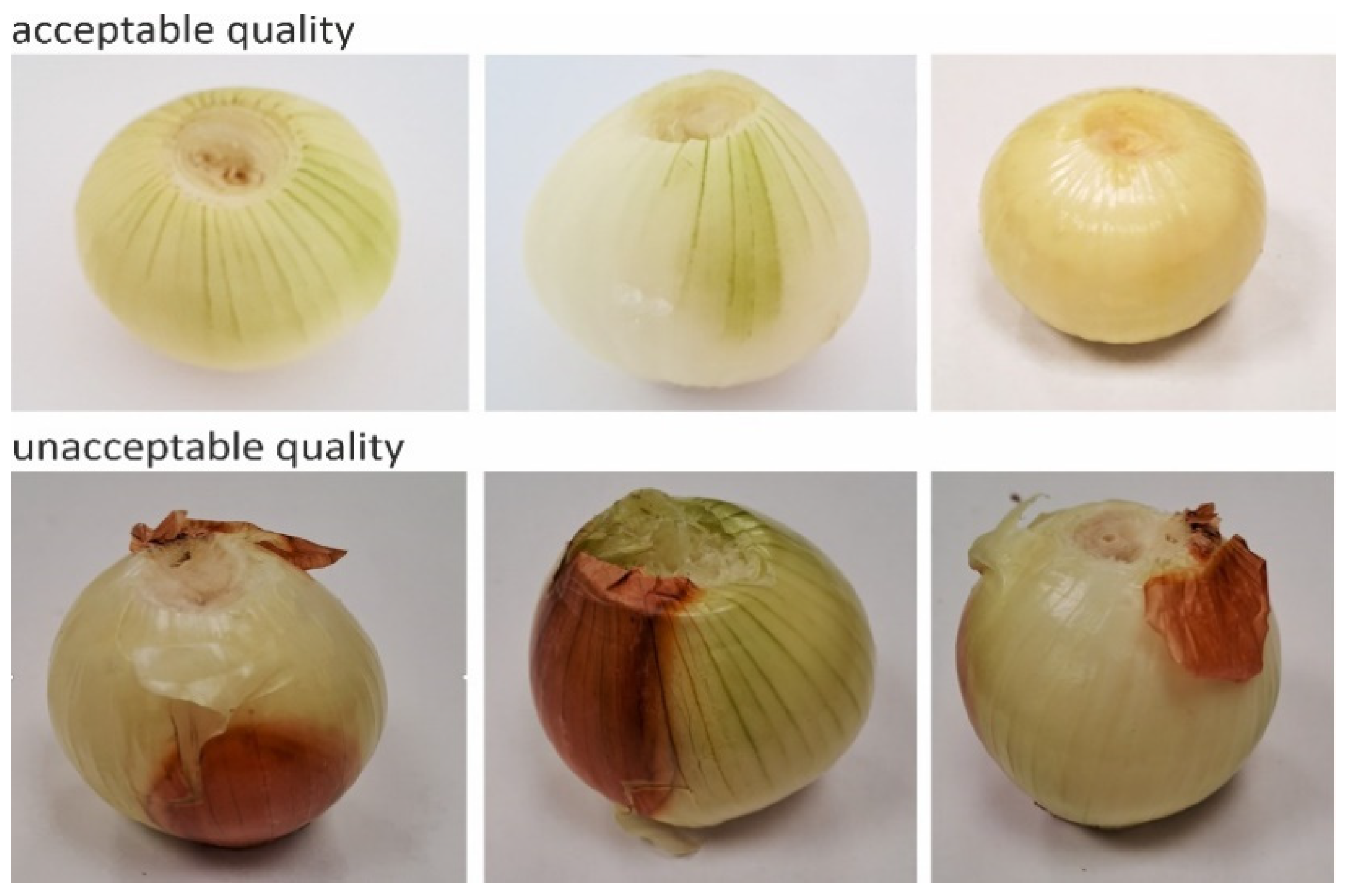
Figure 4.
Cutting unit: (a)—pressure element with rotating knives mounted in the upper and lower parts in the positioning socket; (b)—circular knives cutting the skin.
Figure 4.
Cutting unit: (a)—pressure element with rotating knives mounted in the upper and lower parts in the positioning socket; (b)—circular knives cutting the skin.

Figure 5.
Onion skin blowing unit mounted in the transport chute.
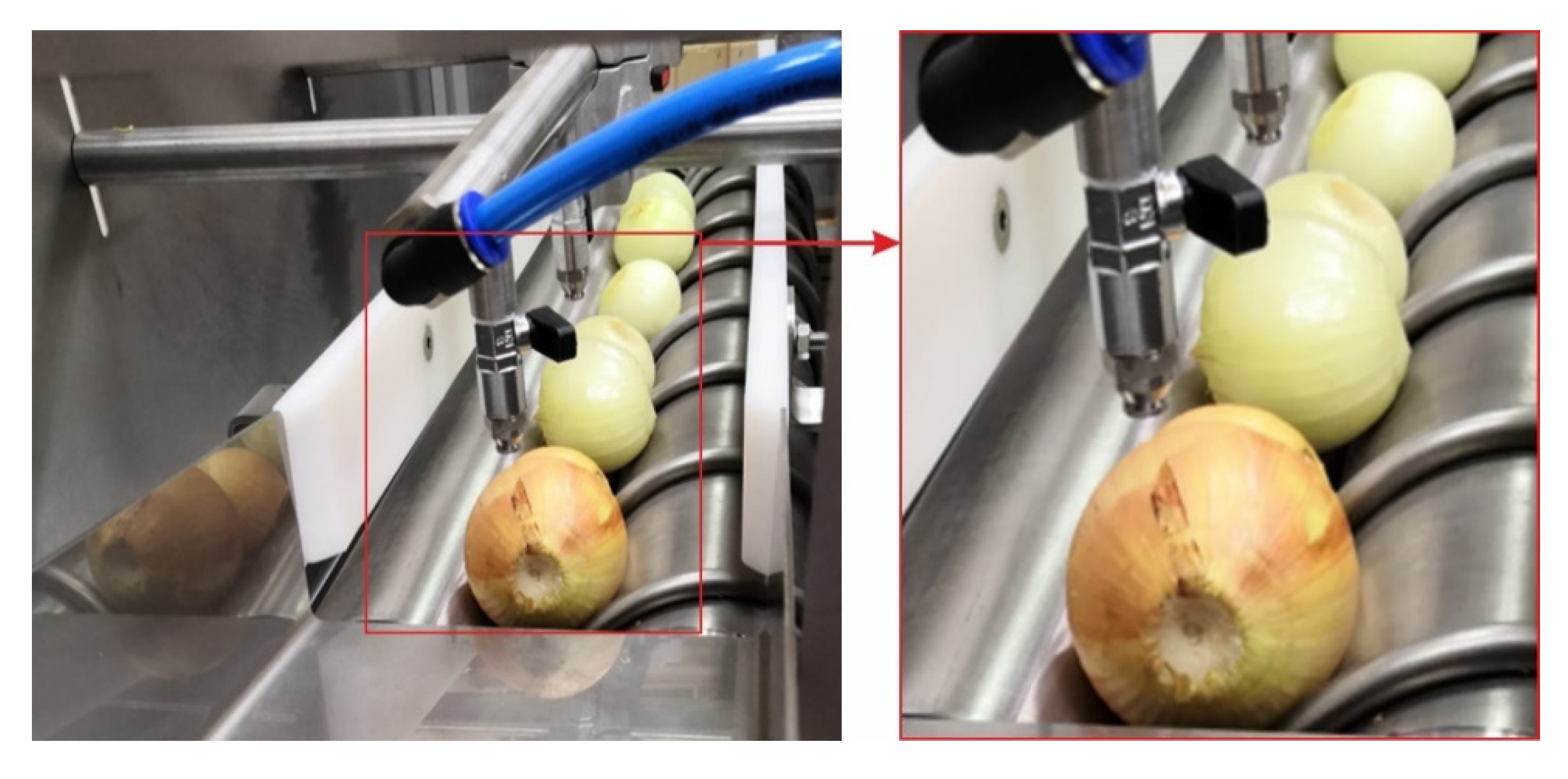
Figure 6.
Graph of skin percentage content depending on the variant of the applied pressure and blowing time (n = 20, α = 0.05; letters indicate homogeneous groups of results within a given parameter), p—pressure [bar]; E—peeling efficiency of onion skin [%].
Figure 6.
Graph of skin percentage content depending on the variant of the applied pressure and blowing time (n = 20, α = 0.05; letters indicate homogeneous groups of results within a given parameter), p—pressure [bar]; E—peeling efficiency of onion skin [%].
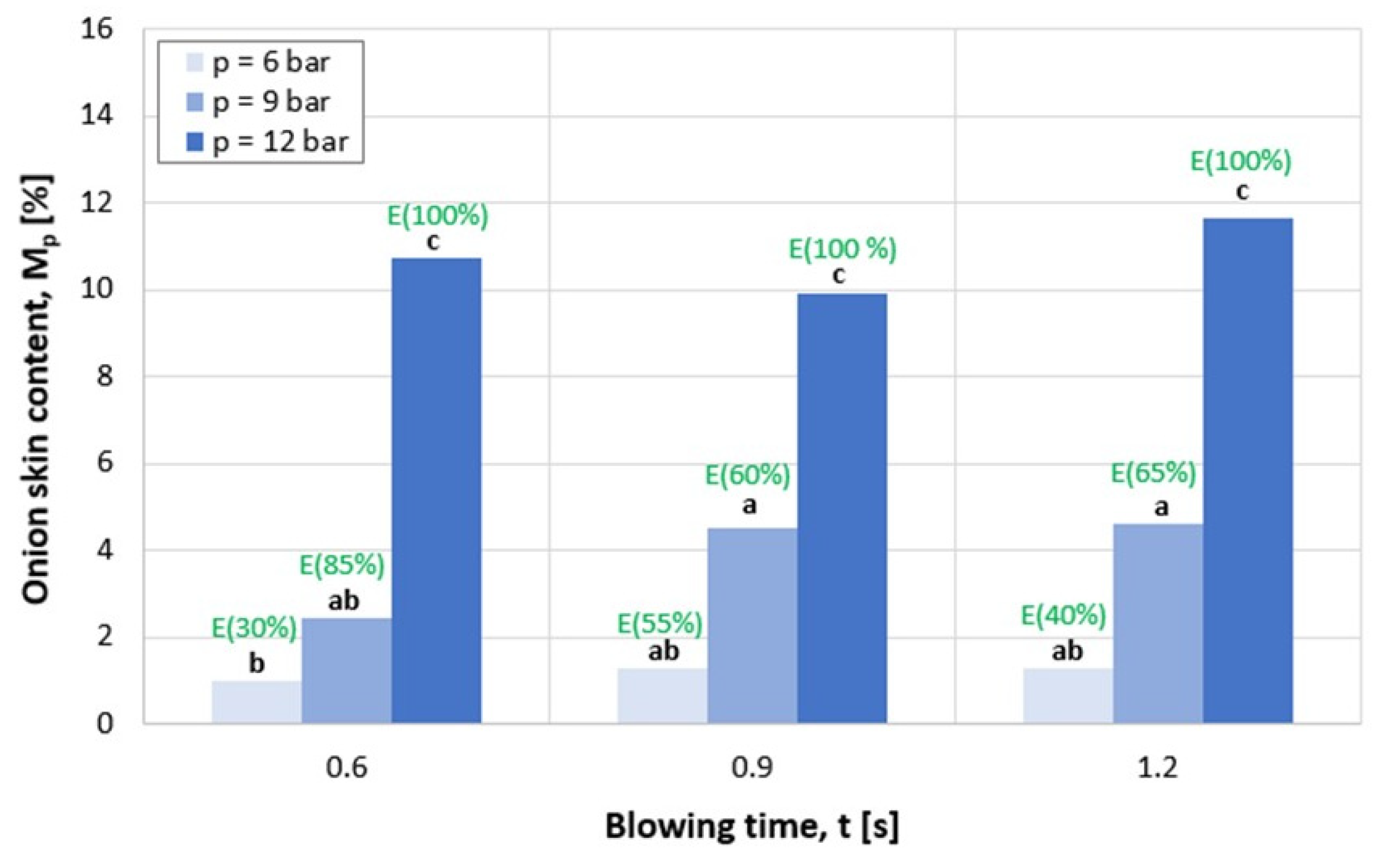
Figure 7.
Pareto chart of effects for a quick visual assessment of the significance of input parameters impact on the % loss of onion mass in the form of skin; (a)—for cumulative effects (acceptable and unacceptable onion purity); (b)—only for acceptable effects (for the significance level α = 0.05).
Figure 7.
Pareto chart of effects for a quick visual assessment of the significance of input parameters impact on the % loss of onion mass in the form of skin; (a)—for cumulative effects (acceptable and unacceptable onion purity); (b)—only for acceptable effects (for the significance level α = 0.05).
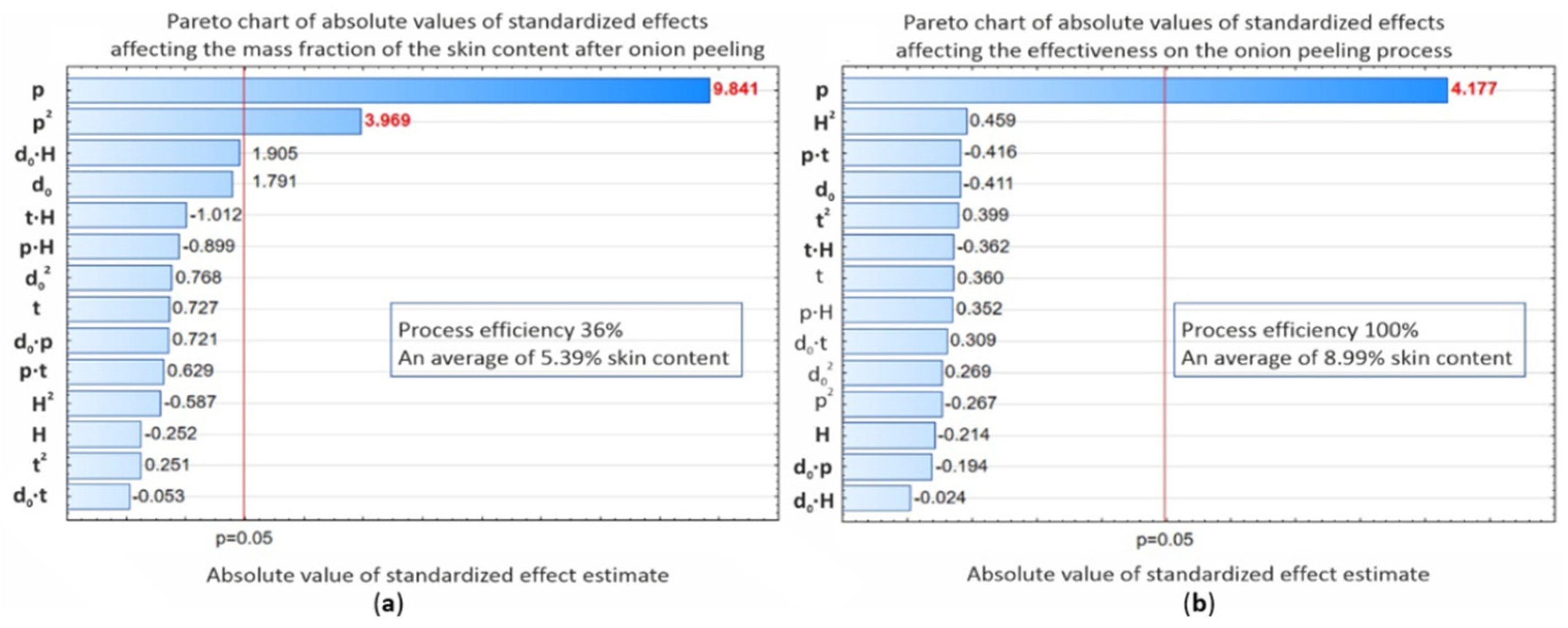
Figure 8.
Dependence of skin percentage content removed at the stage of blowing in relation to: (a,b,c)—substitute onion diameter; (d,e,f)—onion hardness average.
Figure 8.
Dependence of skin percentage content removed at the stage of blowing in relation to: (a,b,c)—substitute onion diameter; (d,e,f)—onion hardness average.
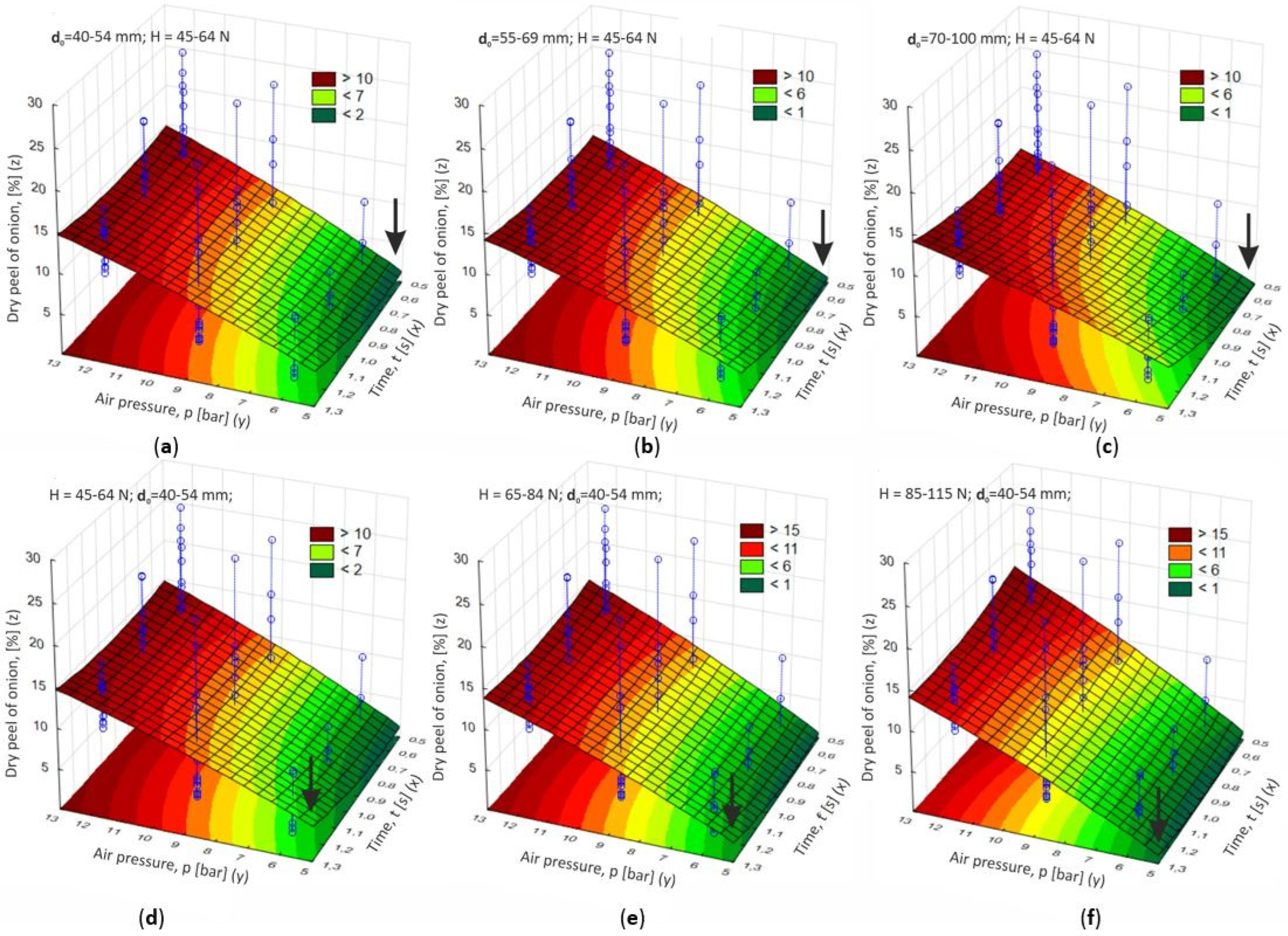
Figure 9.
Waste in the onion peeling process; (a)—peel scales after blowing at 6 bar; (b)—peel scales and fleshy leaves after blowing process at 9 bar; (c)—peel scales and fleshy leaves after blowing process at 12 bar.
Figure 9.
Waste in the onion peeling process; (a)—peel scales after blowing at 6 bar; (b)—peel scales and fleshy leaves after blowing process at 9 bar; (c)—peel scales and fleshy leaves after blowing process at 12 bar.
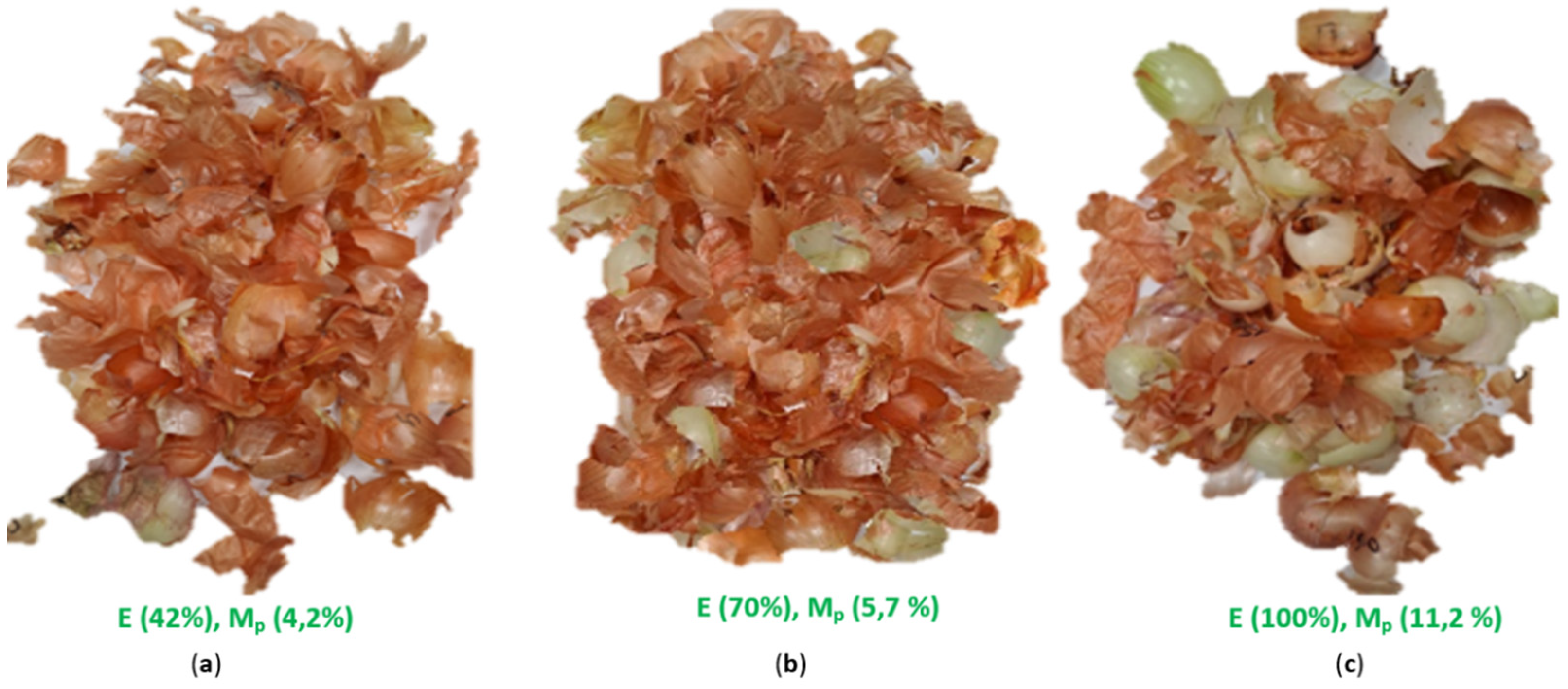
Figure 10.
Dependence of percentage content skin removed in the onion blowing process in relation to the opening time of the control valve and the air pressure: (a)—response area of observed versus predicted values; (b)—response area of observed versus predicted values, taking into account the minimization of waste in the range of 5 to 7% for a short valve opening time t = 0.5 s; c—area response of observed versus predicted values, taking into account waste minimization in the range of 5 to 7% for long valve opening time t = 1.3 s.
Figure 10.
Dependence of percentage content skin removed in the onion blowing process in relation to the opening time of the control valve and the air pressure: (a)—response area of observed versus predicted values; (b)—response area of observed versus predicted values, taking into account the minimization of waste in the range of 5 to 7% for a short valve opening time t = 0.5 s; c—area response of observed versus predicted values, taking into account waste minimization in the range of 5 to 7% for long valve opening time t = 1.3 s.

Disclaimer/Publisher’s Note: The statements, opinions and data contained in all publications are solely those of the individual author(s) and contributor(s) and not of MDPI and/or the editor(s). MDPI and/or the editor(s) disclaim responsibility for any injury to people or property resulting from any ideas, methods, instructions or products referred to in the content. |
© 2023 by the authors. Licensee MDPI, Basel, Switzerland. This article is an open access article distributed under the terms and conditions of the Creative Commons Attribution (CC BY) license (http://creativecommons.org/licenses/by/4.0/).
Copyright: This open access article is published under a Creative Commons CC BY 4.0 license, which permit the free download, distribution, and reuse, provided that the author and preprint are cited in any reuse.
MDPI Initiatives
Important Links
© 2024 MDPI (Basel, Switzerland) unless otherwise stated







